- Growing Echinacea in Your Garden
- 1. Choosing the right location
- 2. Planting Echinacea
- 3. Watering and care
- 4. Propagation
- Types of Echinacea
- 1. Echinacea purpurea
- 2. Echinacea angustifolia
- 3. Echinacea pallida
- 4. Echinacea paradoxa
- 5. Echinacea hybrids
- 6. Echinacea cultivars
- Popular Varieties of Echinacea
- Caring for Echinacea Plants
- 1. Planting
- 2. Watering
- 3. Fertilizing
- 4. Deadheading
- 5. Dividing
- 6. Pests and Diseases
- Harvesting and Using Echinacea
- 1. Harvesting Echinacea
- 2. Drying Echinacea
- 3. Using Echinacea
- 4. Potential Side Effects and Precautions
- Benefits and Uses of Echinacea
- 1. Boosts the immune system
- 2. Fights off infections
- 3. Reduces inflammation
- 4. Supports wound healing
- 5. Allergies and respiratory health
- 6. Digestive health
- 7. Skin health
- Final Thoughts on Echinacea
- Questions and Answers:
- What is Echinacea?
- How can I grow Echinacea in my garden?
- Are there different types of Echinacea?
- What are some popular varieties of Echinacea?
- Can Echinacea be used for medicinal purposes?
- How long does it take for Echinacea to bloom?
- Is Echinacea easy to care for?
- Videos: Best Echinacea Varieties // Coneflower Trial Results // Yanking Coneflowers In A Panic!
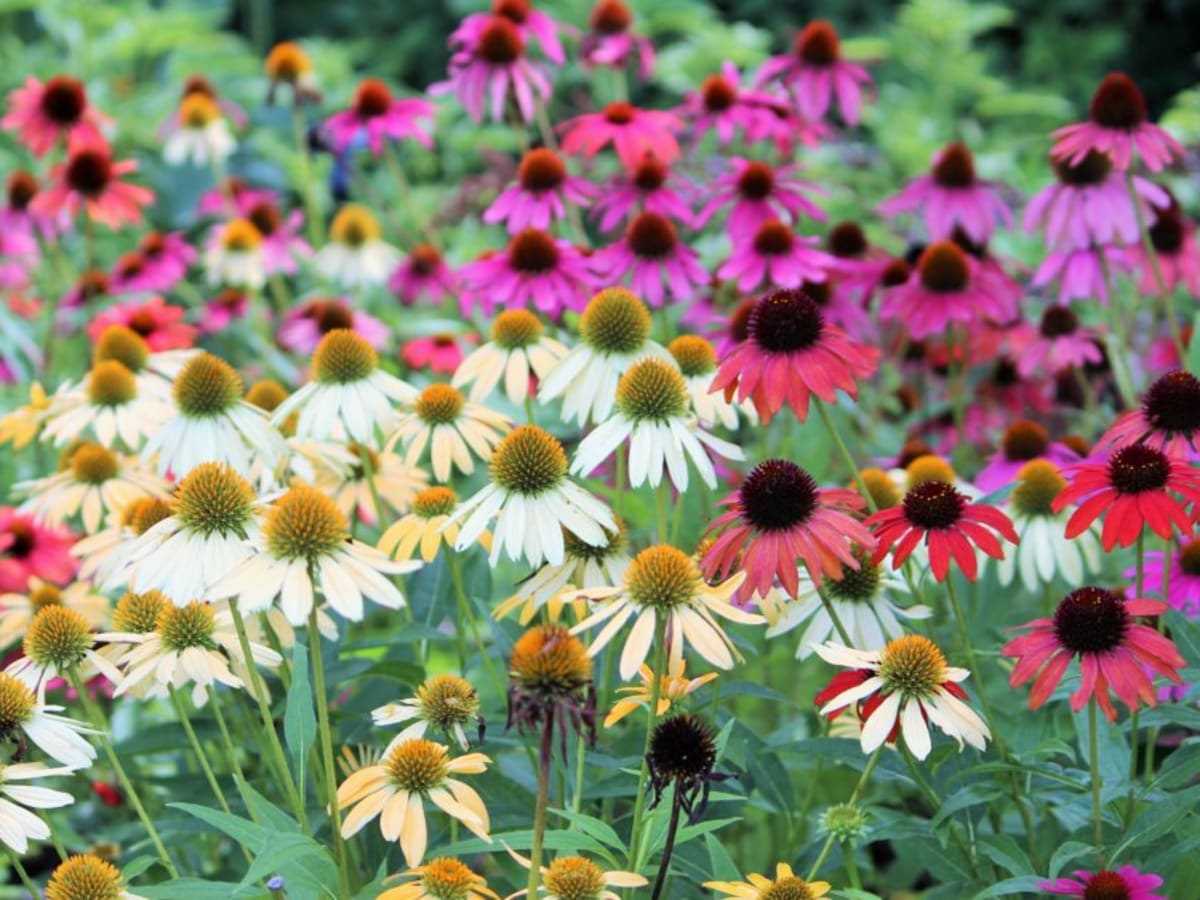
When it comes to beautiful and easy-to-grow flowers, echinacea is a popular choice for garden enthusiasts. Belonging to the daisy family, this vibrant and medicinal plant adds a splash of color to any garden and provides numerous benefits. In this article, we will explore everything you need to know about growing echinacea in your garden, including its different types and varieties.
Echinacea, also known as coneflower, is native to North America and has long been valued for its medicinal properties. The plant’s roots, leaves, and flowers are known for their immune-boosting and anti-inflammatory properties, making echinacea a staple in traditional herbal medicine. Additionally, the vibrant petals of echinacea flowers attract butterflies and other pollinators, making them a great addition to any pollinator-friendly garden.
One of the reasons why echinacea is so popular among gardeners is its hardiness. Echinacea is a tough plant that can withstand hot summers, dry conditions, and even frost. It thrives in well-drained soil and is relatively low-maintenance, making it an ideal choice for beginner gardeners. Echinacea can be planted in both sunny and partially shaded areas of the garden, adding versatility to its appeal.
Echinacea comes in a variety of types and varieties, each with its own unique characteristics. The most common type is Echinacea purpurea, which features vibrant pink to purple petals and a cone-shaped center. Other popular varieties include Echinacea angustifolia, which has narrow and drooping petals, and Echinacea pallida, which has long and pale pink petals. No matter the type or variety you choose, echinacea is sure to add beauty, color, and medicinal benefits to your garden.
Growing Echinacea in Your Garden
Echinacea, also known as coneflower, is a beautiful and easy-to-grow perennial that is a favorite among gardeners. Its vibrant flowers and ability to attract pollinators make it a great addition to any garden. Here are some tips for growing Echinacea in your garden:
1. Choosing the right location
- Echinacea prefers full sun, so choose a location in your garden that receives at least 6 hours of direct sunlight per day.
- Make sure the soil is well-draining and fertile. Echinacea can tolerate a wide range of soil types, but it prefers slightly alkaline soil.
- Avoid planting Echinacea in areas with poor drainage, as it can be prone to root rot.
2. Planting Echinacea
- Plant Echinacea in early spring or late fall.
- Dig a hole that is slightly larger than the root ball of the plant.
- Place the plant in the hole, making sure that the crown is level with the surface of the soil.
- Backfill the hole with soil and gently press it down to eliminate any air pockets.
- Water the plant thoroughly after planting.
3. Watering and care
- Water Echinacea regularly, especially during dry spells, but be careful not to overwater it. The plant prefers slightly dry conditions.
- Apply a layer of mulch around the base of the plant to help retain moisture and suppress weeds.
- Deadhead the flowers regularly to encourage new blooms.
- In late fall, cut back the stems of the plant to the ground to prepare it for the winter.
4. Propagation
- Echinacea can be propagated by division in early spring or late fall. Simply dig up the plant and divide the root ball into several sections, making sure each section has some roots attached.
- Replant the divisions in well-prepared soil and water thoroughly.
- Alternatively, you can propagate Echinacea from seeds. Collect the seeds from the dried flower heads and sow them directly in the garden in late fall. The seeds will germinate in the following spring.
By following these simple tips, you can enjoy the beauty of Echinacea in your garden year after year. Whether you choose to grow it as a standalone plant or incorporate it into a mixed border, Echinacea is sure to brighten up your garden with its vibrant colors and attract pollinators to help your other plants thrive.
Types of Echinacea
Echinacea, also known as coneflower, comes in several different types and varieties. Each type offers unique characteristics and benefits. Here are some of the most common types of echinacea:
1. Echinacea purpurea
Echinacea purpurea, or purple coneflower, is the most popular and widely cultivated type of echinacea. It has long-lasting petals that bloom in shades of pink, purple, or white. This type is known for its medicinal properties and is often used to boost the immune system and alleviate cold and flu symptoms.
2. Echinacea angustifolia
Echinacea angustifolia, or narrow-leaf coneflower, is a native species to North America. It has slender leaves and upward-facing pink or pale purple petals. This type is highly valued for its immune system-stimulating properties and is commonly used in herbal remedies.
3. Echinacea pallida
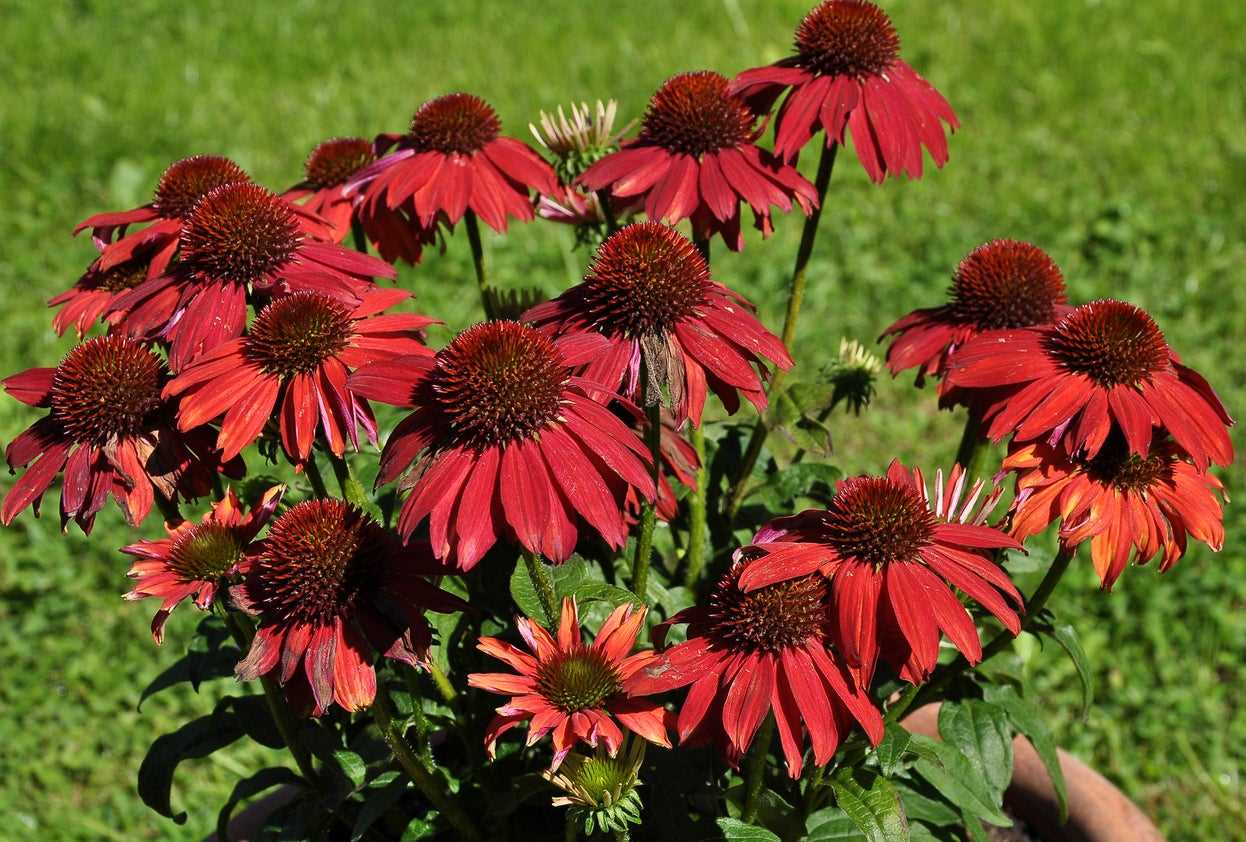

Echinacea pallida, also known as pale coneflower, has long, slender petals in pale pink or white colors. It is often found in prairies and open meadows. This type of echinacea is less commonly cultivated but is still highly valued for its medicinal properties.
4. Echinacea paradoxa
Echinacea paradoxa, or yellow coneflower, is a unique type of echinacea that stands out with its vibrant yellow petals. It is the only echinacea species that produces yellow flowers naturally. This type is sought after for its unique color and is often used in landscaping.
5. Echinacea hybrids
In addition to the different species, there are also many hybrid varieties of echinacea available. These hybrids are created by crossbreeding different types of echinacea to produce unique colors, flower shapes, and sizes. Some popular hybrid varieties include ‘Magnus’, ‘PowWow White’, and ‘Cheyenne Spirit’.
6. Echinacea cultivars
There are also numerous cultivars of echinacea, each with its own specific characteristics. Cultivars are often bred for improved disease resistance, flower size, or unique traits. Some popular cultivars include ‘Hot Papaya’, ‘Green Envy’, and ‘Ruby Star’.
<
Popular Varieties of Echinacea
Echinacea, also known as coneflower, is a popular garden plant known for its attractive flowers and medicinal properties. There are several different varieties of echinacea, each with its own unique characteristics. Here are some of the most popular varieties:
Echinacea purpurea: This is the most commonly grown variety of echinacea. It has large pink to purple flowers with a prominent cone-shaped center. Echinacea purpurea is known for its hardiness and ability to attract butterflies and bees to the garden.
Echinacea pallida: This variety is often called pale purple coneflower. It has pale pink to lavender flowers and narrow petals that give it a delicate appearance. Echinacea pallida is generally taller than other varieties and requires well-drained soil.
Echinacea angustifolia: Also known as narrow-leaved coneflower, this variety has narrow, elongated petals and a cone-shaped center. It is native to the prairies of the Midwest and is known for its drought tolerance.
Echinacea paradoxa: This variety is commonly called yellow coneflower. It has pale yellow flowers with drooping petals and a greenish-yellow cone-shaped center. Echinacea paradoxa is a rare variety that adds a pop of color to the garden.
These are just a few examples of the many varieties of echinacea available to gardeners. Each variety offers its own unique colors, shapes, and sizes, making echinacea a versatile and popular choice for garden enthusiasts.
Caring for Echinacea Plants
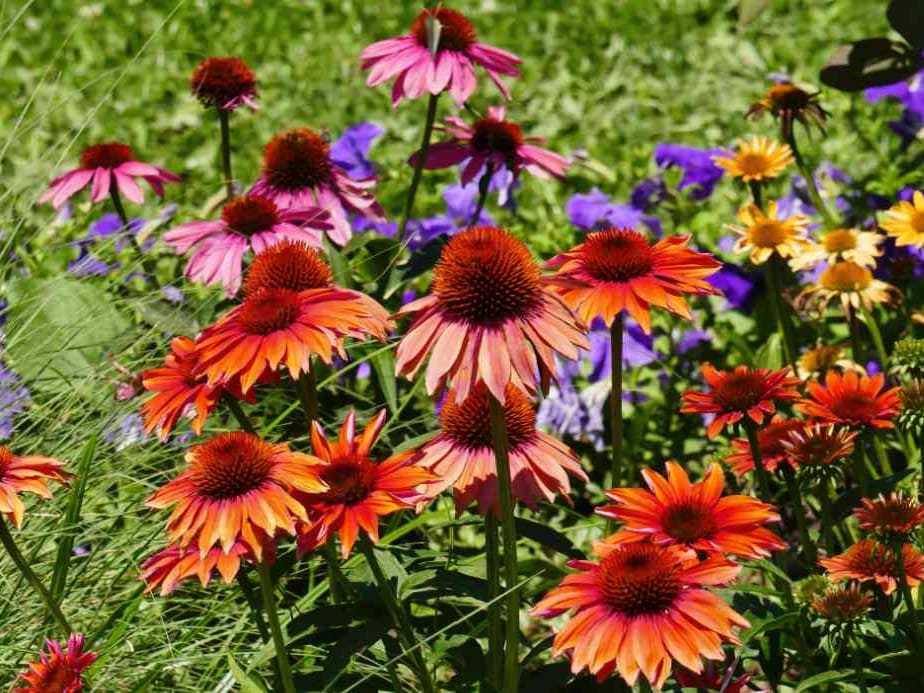

Echinacea plants are relatively low-maintenance and easy to care for. By following a few simple steps, you can ensure that your echinacea plants thrive and produce beautiful blooms. Here are some tips for caring for your echinacea plants:
1. Planting
- Choose a sunny location with well-drained soil for planting your echinacea plants.
- Dig a hole that is slightly larger than the root ball of the plant.
- Place the plant in the hole and backfill with soil, gently firming it around the roots.
- Water the plant thoroughly after planting to help it establish roots.
2. Watering
- Water your echinacea plants regularly, especially during dry periods.
- Avoid overwatering, as echinacea plants prefer slightly drier conditions.
- Water at the base of the plant rather than overhead to prevent fungal diseases.
3. Fertilizing
- Echinacea plants generally do not require much fertilization.
- If desired, you can apply a balanced fertilizer once or twice during the growing season.
- Follow the instructions on the fertilizer package for application rates and timing.
4. Deadheading
- To encourage continuous blooming, deadhead the faded flowers regularly.
- Simply snip off the spent flower heads to keep the plant looking tidy and to promote new flower production.
5. Dividing
- Every three to four years, divide your echinacea plants to maintain their vigor.
- Dividing can be done in early spring or early fall.
- Dig up the plant and use a sharp knife or shovel to divide the crown into smaller sections.
- Replant the divided sections, making sure to provide them with enough space to grow.
6. Pests and Diseases
- Echinacea plants are generally resistant to pests and diseases.
- However, they can occasionally be affected by aphids, slugs, or powdery mildew.
- If necessary, use insecticidal soap or organic controls to manage pests.
- Ensure good air circulation around the plants to prevent powdery mildew.
By following these care tips, you can enjoy the beauty of echinacea plants in your garden and attract pollinators like bees and butterflies.
Harvesting and Using Echinacea
Harvesting echinacea is an important step in utilizing its medicinal properties. Here are some tips on how to harvest and use echinacea effectively:
1. Harvesting Echinacea
Echinacea flowers should be harvested when they are fully open and in their prime. This is usually in the late summer or early fall. Look for flowers with vibrant colors and petals that are fully expanded.
To harvest echinacea, cut the flowers at the base of the stem using clean, sharp scissors or pruners. It’s best to harvest in the morning, after the dew has dried but before the heat of the day.
2. Drying Echinacea
After harvesting, the echinacea flowers need to be dried. This can be done by spreading them out on a clean, dry surface. Make sure to remove any dirt or debris.
Place the flowers in a well-ventilated area, away from direct sunlight. Allow them to dry for about 1-2 weeks, or until the flowers feel crispy and the petals easily crumble when rubbed between your fingers.
Once dried, store echinacea flowers in an airtight container, away from moisture and light, to maintain their potency.
3. Using Echinacea
Echinacea can be used in various forms, depending on your preferences and needs:
- Tea: To make echinacea tea, steep 1-2 teaspoons of dried echinacea flowers in a cup of boiling water for 10-15 minutes. Strain and drink hot or cold. Echinacea tea is known for its immune-boosting properties.
- Tincture: Echinacea tincture is made by soaking dried echinacea flowers in alcohol or glycerin. This is a concentrated form of echinacea and is commonly used for immune support. Follow the instructions on the tincture bottle for proper dosage.
- Capsules or tablets: Echinacea supplements are available in the form of capsules or tablets. These are convenient and easy to take, especially for those who don’t enjoy the taste of echinacea tea.
4. Potential Side Effects and Precautions
While echinacea is generally considered safe, it’s important to take certain precautions:
- Allergies: If you have a known allergy to plants in the daisy family, such as ragweed or marigold, it’s possible to have an allergic reaction to echinacea.
- Autoimmune conditions: Echinacea may stimulate the immune system, which can be problematic for individuals with autoimmune conditions. Consult with a healthcare professional before using echinacea if you have such a condition.
- Medication interactions: Echinacea may interact with certain medications, such as immunosuppressants and drugs that are metabolized by the liver. If you are taking any medications, it’s best to consult with your healthcare provider before using echinacea.
By following these guidelines, you can harvest and use echinacea effectively to enjoy its potential health benefits.
Benefits and Uses of Echinacea
Echinacea, also known as coneflower, is a popular herb that offers a range of health benefits. It has been used for centuries in traditional medicine to boost the immune system and promote overall wellness. Here are some of the benefits and uses of echinacea:
1. Boosts the immune system
Echinacea is renowned for its immune-boosting properties. It stimulates the production of white blood cells, which are essential for fighting off infections and diseases. Regular consumption of echinacea can help strengthen your body’s natural defense mechanisms.
2. Fights off infections
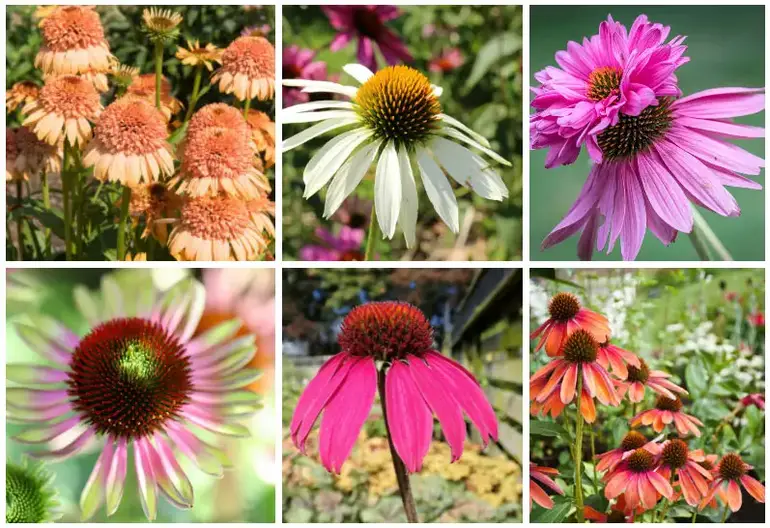

Thanks to its antibacterial and antiviral properties, echinacea is often used to treat and prevent various infections. It can be effective against respiratory infections, such as the common cold, flu, and bronchitis. Echinacea supplements or teas are commonly taken at the onset of illness to help reduce the severity and duration of symptoms.
3. Reduces inflammation
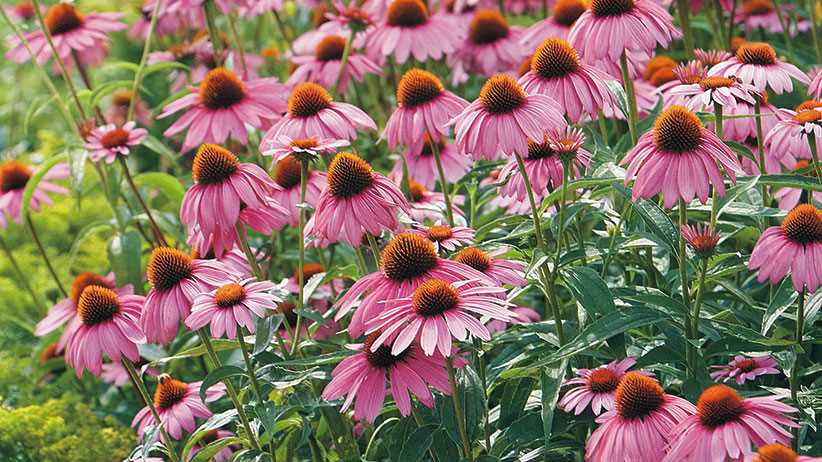

Echinacea has anti-inflammatory properties that can help reduce inflammation in the body. This makes it useful for relieving symptoms of inflammatory conditions, such as arthritis, rheumatism, and skin irritations. It may also help with reducing pain and swelling.
4. Supports wound healing
Echinacea has been found to promote wound healing and tissue regeneration. Its antimicrobial properties can help prevent infections in wounds or cuts, while its anti-inflammatory properties can reduce swelling and promote faster healing.
5. Allergies and respiratory health
Echinacea may help relieve symptoms associated with allergies and respiratory conditions, such as asthma and sinusitis. It can help reduce inflammation in the airways and improve overall respiratory health.
6. Digestive health
Echinacea stimulates digestion and can help reduce digestive issues, such as indigestion, bloating, and stomach cramps. It may also help improve appetite and promote a healthy digestive system.
7. Skin health
The anti-inflammatory and antimicrobial properties of echinacea make it beneficial for promoting healthy skin. It can help soothe irritations, reduce redness and inflammation, and prevent acne breakouts.
Echinacea is available in various forms, including supplements, teas, tinctures, and creams. It is generally safe for most people when used in recommended doses. However, it is always best to consult with a healthcare professional before starting any new herbal supplement or treatment.
Final Thoughts on Echinacea
Echinacea is a beautiful and versatile plant that can make a valuable addition to any garden. Whether you are interested in its medicinal properties or simply want to enjoy its vibrant colors, there are many reasons to consider growing Echinacea.
When choosing from the various types and varieties of Echinacea, it is important to consider your specific needs and preferences. Some varieties may be better suited for use as herbal remedies, while others may be more desirable for their ornamental value.
Regardless of the variety you choose, Echinacea is a plant that is relatively easy to grow. It is native to North America and is well adapted to a wide range of growing conditions. With proper care, it can thrive in both sunny and partially shaded areas.
One of the key benefits of growing Echinacea is its ability to attract pollinators such as bees and butterflies. These insects play a vital role in the pollination of many plants, including food crops. By growing Echinacea, you can help support the local pollinator populations and contribute to the overall health of your garden ecosystem.
Another advantage of Echinacea is its long blooming period. Depending on the variety, Echinacea can produce colorful flowers from early summer through late fall. This extended blooming period provides beauty and interest in the garden for several months.
Overall, Echinacea offers a range of benefits for gardeners. Whether you are interested in its medicinal properties, its ornamental value, or its ability to support pollinators, Echinacea is a plant worth considering for your garden. With its vibrant flowers, easy care, and adaptability to different growing conditions, it is sure to bring beauty and enjoyment to your outdoor space.
Questions and Answers:
What is Echinacea?
Echinacea, also known as coneflower, is a flowering plant native to North America. It is characterized by its showy daisy-like flowers and spiky central cones.
How can I grow Echinacea in my garden?
To grow Echinacea in your garden, start by selecting a sunny spot with well-drained soil. Sow the seeds in spring or early summer, or plant young plants in the ground. Water regularly and provide occasional feedings. Ensure proper spacing between plants to allow for good air circulation.
Are there different types of Echinacea?
Yes, there are several different types of Echinacea. The most common ones include Echinacea purpurea, Echinacea angustifolia, and Echinacea pallida. Each type has its own unique characteristics and medicinal properties.
What are some popular varieties of Echinacea?
Some popular varieties of Echinacea include ‘Magnus’, ‘White Swan’, ‘PowWow Wild Berry’, and ‘Sunrise’. These varieties are known for their vibrant colors, compact growth habits, and long-lasting blooms.
Can Echinacea be used for medicinal purposes?
Yes, Echinacea has long been used for its medicinal properties. It is believed to boost the immune system and help with various ailments, such as colds, flu, and respiratory infections. However, it’s always best to consult with a healthcare professional before using Echinacea for medicinal purposes.
How long does it take for Echinacea to bloom?
Echinacea typically blooms in its second or third year of growth. However, some varieties may start blooming in the first year. Once established, Echinacea will continue to bloom for several weeks, attracting bees and butterflies to your garden.
Is Echinacea easy to care for?
Yes, Echinacea is relatively easy to care for. It is a hardy plant that tolerates a wide range of growing conditions. It requires regular watering, especially during dry spells, and occasional feedings. Deadheading spent flowers will encourage more blooms. Overall, Echinacea is a low-maintenance plant that adds beauty to any garden.







